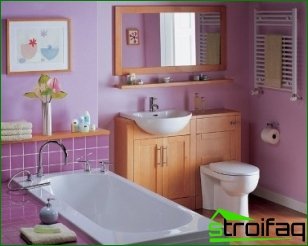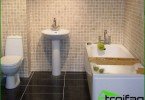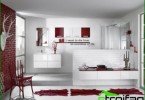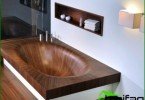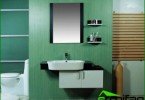As we said, painting the walls in the bathroom is very popular. If you decide to use this particular type of finish, it is important for you to get acquainted with its strengths and weaknesses. We will not dwell on this issue for a long time, since a lot has been said about this in the last article. We will only say that painting is a budget type of finish, which, when arranging the ventilation system, can last quite a long time. The main disadvantage of this method is the complexity of the preparatory phase. Let’s take a closer look at how to properly prepare the walls for painting.
As we said, painting the walls in the bathroom is very popular. If you decide to use this particular type of finish, it is important for you to get acquainted with its strengths and weaknesses. We will not dwell on this issue for a long time, since a lot has been said about this in the last article. We will only say that painting is a budget type of finish, which, when arranging the ventilation system, can last quite a long time. The main disadvantage of this method is the complexity of the preparatory phase. Let’s take a closer look at how to properly prepare the walls for painting.We prepare the walls for painting
From the very beginning it is necessary to conduct a detailed inspection of the wall surface for defects and damage. To eliminate them, various solutions are used. The most popular are putty and plaster mixes..
To prepare the plaster, you need sand, cement and water. A sand-cement mixture is obtained by mixing 1 part cement and 3 parts sand. It is necessary to achieve the formation of a creamy composition. To get a flat surface, you will need putty.
The bathroom is a specific room, since it is often operated in high humidity. This point must be considered when choosing a putty. The material must be able to withstand a high level of humidity for a long time. Fine latex substances intended for interior decoration fully meet these requirements. Thanks to them, it is possible to obtain surfaces from which, even in conditions of high humidity, the coating will not peel off.
Correct puttying technology
As a rule, the surface of the wall is putty in 2 layers. Using the first layer, the base is leveled. Therefore, it is prepared in high density and applied in large thickness. Using the first layer of putty, it is possible to hide the level differences of the walls, as well as to get rid of both small and large defects. The purpose of the second layer is the finish. It is applied in a small thickness and is designed to hide all the bumps in the first layer..
Before applying each subsequent putty coat, wait until the previous one has completely dried. It is best to wait about a day, although in warm weather and with good ventilation you can apply both layers in one day. Better painting the walls in the bathroom will happen when, after drying the first layer, its surface will be treated with a moisture-resistant primer with deep penetration.
Remember that in the bathroom there is an increased likelihood of mold formation. To protect against this phenomenon, treat the surface of the primer with an antiseptic compound or paint the walls with a thin layer of acrylic paint. It contains fungicides and algaecides, which play the role of antifungal elements.
Very, very much depends on the preparation of the walls for painting. The quality of this step will determine the service life of the decorative coating. Therefore, work on the preparation of walls with their subsequent plastering and puttying should be done with utmost attention. Only in this case you can provide a long service life.
